A Collaborative Trans-Regional R&D Strategy for the South Korea Green New Deal to Achieve Future Mobility
Abstract
:1. Introduction
1.1. Theoretical Background and Literature Review
1.1.1. Inherent Purpose of Korean Green New Deal
1.1.2. Organizational Structure of the National Strategy
1.1.3. Future Mobility Policies of Korea
1.1.4. Need for Developing a Systematic Framework for a Collaborative Trans-Regional R&D Strategy Plan
1.1.5. Changes in Sustainable Urban Mobility Modes in the Post-COVID-19 Era
1.2. Research Purpose and Research Questions
- Research Question RQ1: How much did the Korean government invest in regional future mobility from the perspective of automotive company locations during the period 2015–2020?
- Research Question RQ2-1: What was the distribution of investment in future mobility-related technology areas in 2015–2020?
- Research Question RQ2-2: What trends of investment in technology areas emerged during this period?
- Research Question RQ3-1: What was the regional distribution of investment in future mobility-related technology areas?
- Research Question RQ3-2: What types of organizations (among academia, industry, and research institutes) have played an important role in future mobility-related technology areas from a regional perspective?
- Research Question RQ4: What organizations related to future mobility-related technology areas may serve as trans-regional collaborative R&D partners from a regional perspective?
2. Materials and Methods
2.1. Data Collection and Preprocessing
2.2. Co-Occurrence Matrix
2.3. Clustering and Network Visualization
2.4. Defining the Goals of Future Mobility-Related Research Fields
3. Results
3.1. Future Mobility-Related Research Fields of Nationally Funded Projects
- Cluster 1. Core electric/electronic sub-assembly for green cars. Research on the core electric and electronic sub assembly for autonomous and electric vehicles; dynamic control applications to future cars (i.e., electric motor, power conversion system).
- Cluster 2. Intelligent vehicle communication. Research on vehicle-to-vehicle and vehicle-to-infrastructure communication for controlling road transport service (i.e., V2X: Vehicle-to-everything, AUTOSAR Adaptive Platform).
- Cluster 3. Hydrogen charging infrastructure. Research on production and storage for hydrogen vehicles, charging interfaces, and management of hydrogen stations.
- Cluster 4. Autonomous vehicle service platform. Research on vehicle platforms, edge platforms, and clouds for autonomous driving services (i.e., MaaS: Mobility-as-a-Service, TaaS: Transportation as a Service).
- Cluster 5. Battery charging infrastructure. Research on production and storage for electric vehicles, charging interfaces, and management of electric stations.
- Cluster 6. Precision maps for human safety. Research on dynamic and static map generation, high precision positioning, and human-machine interface for autonomous vehicles (i.e., LDM: Local Dynamic Map, IMU: Inertial Measurement Unit).
- Cluster 7. Intelligent road transport information. Research on road and environment conditions, including object detection and tracking, pedestrian detection, and road sign recognition-based optimal driving support services for autonomous vehicles (i.e., C-ACC: Cooperative Adaptive Cruise Control, LCS: Lane Control System).
3.2. Status of Government Investment in Future Mobility
3.2.1. Status of Government-Funded Projects According to Regions
3.2.2. Status and Trend of Government-Funded Projects According to Technology Clusters
3.2.3. Status of Government-Funded Projects According to Technology Clusters and Regions
3.2.4. Status of Government-Funded Projects According to Technology Clusters, Regions, and Organization Types
3.2.5. Potential National Collaborative Research Organizations According to Technology Clusters
4. Discussion and Conclusions
4.1. Discussion for Collaborative Trans-Regional R&D Strategy on Future Mobility
4.2. Conclusions
4.3. Limitations and Further Research
Author Contributions
Funding
Institutional Review Board Statement
Informed Consent Statement
Data Availability Statement
Conflicts of Interest
References
- Lee, J. Global Value Chain (GVC) and GVC-Oriented Policy: Insights from the South Korean Experience. SSRN Electron. J. 2020, 5, 1–13. [Google Scholar] [CrossRef]
- Miroudot, S. The Reorganization of Global Value Chains in East Asia before and after COVID-19. SSRN Electron. J. 2020, 24, 389–416. [Google Scholar] [CrossRef]
- Vernengo, M.; Nabar-Bhaduri, S. The Economic Consequences of COVID-19: The Great Shutdown and the Rethinking of Economic Policy. Int. J. Polit. Econ. 2020, 49, 265–277. [Google Scholar] [CrossRef]
- Song, Y.; Hao, X.; Hu, Y.; Lu, Z. The Impact of the COVID-19 Pandemic on China’s Manufacturing Sector: A Global Value Chain Perspective. Front. Public Health 2021, 9, 1–13. [Google Scholar] [CrossRef]
- Gereffi, G. What Does the COVID-19 Pandemic Teach Us about Global Value Chains? The Case of Medical Supplies. J. Int. Bus. Policy 2020, 3, 287–301. [Google Scholar] [CrossRef]
- Scherer, F.L.; Minello, I.F.; Krüger, C.; Rizzatti, A.B. To Internationalize or Not to Internationalize? A Descriptive Study of a Brazilian Startup. Technol. Innov. Manag. Rev. 2018, 8, 38–46. [Google Scholar] [CrossRef] [Green Version]
- Bloomfield, J.; Steward, F. The Politics of the Green New Deal. Polit. Q. 2020, 91, 770–779. [Google Scholar] [CrossRef]
- Barbier, E.B. Greening the Post-Pandemic Recovery in the G20. Environ. Resour. Econ. 2020, 76, 685–703. [Google Scholar] [CrossRef] [PubMed]
- Proctor, K.W.; Murthy, G.S.; Higgins, C.W. Agrivoltaics Align with Green New Deal Goals While Supporting Investment in the Us’ Rural Economy. Sustainability 2021, 13, 137. [Google Scholar] [CrossRef]
- Lee, J.-H.; Woo, J. Green New Deal Policy of South Korea: Policy Innovation for a Sustainability Transition. Sustainability 2020, 12, 10191. [Google Scholar] [CrossRef]
- Ministry of Economy and Finance. Korean New Deal. Gov. Repub. Korea. 2020. Available online: Eng-lish.moef.go.kr/co/fixFileDown.do?orgNm=Korean_New_Deal.pdf (accessed on 3 May 2021).
- United Nation. World Social Report 2020; UN. 2020. Available online: https://doi.org/10.18356/7f5d0efc-en (accessed on 20 July 2021).
- Iammarino, S.; Rodriguez-Pose, A.; Storper, M. Regional Inequality in Europe: Evidence, Theory and Policy Implications. J. Econ. Geogr. 2019, 19, 273–298. [Google Scholar] [CrossRef]
- Niño-Zarazúa, M.; Roope, L.; Tarp, F. Global Inequality: Relatively Lower, Absolutely Higher. Rev. Income Wealth 2017, 63, 661–684. [Google Scholar] [CrossRef]
- Nurlanova, N.K.; Satybaldin, A.A.; Bekturganova, M.A.; Kireyeva, A.A. Spatial Distribution of Economic Growth and Inequality: Kazakhstan’s Experience. J. Asian Financ. Econ. Bus. 2018, 5, 169–178. [Google Scholar] [CrossRef]
- Park, S.H.; Shin, H.B.; Kang, H.S. (Eds.) Exporting Urban Korea? Routledge: Oxfordshire, UK, 2020. [Google Scholar] [CrossRef]
- OECD. OECD Economic Surveys: Korea 2020. 2020. Available online: https://www.oecd.org/economy/surveys/korea-2020-OECD-economic-survey-overview.pdf (accessed on 19 June 2021).
- Statistics Korea. Gross Regional Domestic Product (GRDP) in Regions. 2020. Available online: http://www.index.go.kr/potal/main/EachDtlPageDetail.do?idx_cd=1008 (accessed on 19 June 2021).
- Bank of Korea. Trend on Recent Regional Economic. 2020. Available online: https://www.bok.or.kr/portal/bbs/P0002507/view.do?nttId=10061975&menuNo=200069 (accessed on 7 June 2021).
- Ministry of the Interior and Safety. Regionally Balanced New Deal. 2020. Available online: https://www.mois.go.kr/cmm/fms/FileDown.do?atchFileId=FILE_00096782TuDwrFK&fileSn=3 (accessed on 7 June 2021).
- Stangarone, T. South Korean Efforts to Transition to a Hydrogen Economy. Clean Technol. Environ. Policy 2020, 23, 509–516. [Google Scholar] [CrossRef] [PubMed]
- Škrinjarić, T. R&D in Europe: Sector Decomposition of Sources of (in)Efficiency. Sustainability 2020, 12, 1432. [Google Scholar] [CrossRef] [Green Version]
- Tidd, J.; Bessant, J. Managing Innovation: Integrating Technological, Market and Organizational Change, 4th ed.; John Wiley & Sons, Ltd.: Hoboken, NJ, USA, 2005. [Google Scholar]
- Adrián Risso, W.; Sánchez Carrera, E.J. On the Impact of Innovation and Inequality in Economic Growth. Econ. Innov. New Technol. 2019, 28, 64–81. [Google Scholar] [CrossRef]
- Amoroso, S.; Coad, A.; Grassano, N. European R&D Networks: A Snapshot from the 7th EU Framework Programme. Econ. Innov. New Technol. 2018, 27, 404–419. [Google Scholar] [CrossRef]
- Capello, R.; Nijkamp, P. Handbook of Regional Growth and Development Theories; Capello, R., Nijkamp, P., Eds.; Edward Elgar Publishing: Cheltenham, UK, 2019. [Google Scholar] [CrossRef] [Green Version]
- Galvin, R.; Healy, N. The Green New Deal in the United States: What It Is and How to Pay for It. Energy Res. Soc. Sci. 2020, 67, 101529. [Google Scholar] [CrossRef]
- Min, S.; Kim, J.; Sawng, Y.W. The Effect of Innovation Network Size and Public R&D Investment on Regional Innovation Efficiency. Technol. Forecast. Soc. Chang. 2020, 155, 119998. [Google Scholar] [CrossRef]
- Carayannis, E.G.; Alexander, J.; Ioannidis, A. Leveraging Knowledge, Learning, and Innovation in Forming Strategic Government–University–Industry (GUI) R&D Partnerships in the US, Germany, and France. Technovation 2000, 20, 477–488. [Google Scholar] [CrossRef]
- Koschatzky, K.; Sternberg, R. R and D Cooperation in Innovation Systems-Some Lessons from the European Regional Innovation Survey (ERIS). Eur. Plan. Stud. 2000, 8, 487–501. [Google Scholar] [CrossRef]
- Kapustin, N.O.; Grushevenko, D.A. Long-Term Electric Vehicles Outlook and Their Potential Impact on Electric Grid. Energy Policy 2020, 137, 111103. [Google Scholar] [CrossRef]
- Camagni, R.; Capello, R. Regional Innovation Patterns and the EU Regional Policy Reform: Towards Smart Innovation Policies. In Seminal Studies in Regional and Urban Economics; Springer International Publishing: Cham, Switzerland, 2017; Volume 44. [Google Scholar] [CrossRef] [Green Version]
- Tödtling, F.; Trippl, M.; Frangenheim, A. Policy Options for Green Regional Development: Adopting a Production and Application Perspective. Sci. Public Policy 2021, 47, 865–875. [Google Scholar] [CrossRef]
- Ritchie, H. Cars, Planes, Trains: Where Do CO2 Emissions from Transport Come from? 2020. Available online: https://www.weforum.org/agenda/2020/10/cars-planes-trains-aviation-co2-emissions-transport/ (accessed on 19 July 2021).
- Government of the Republic of Korea. 2050 Carbon Neutral Strategy of the Republic of Korea: Towards a Sustainable and Green Society. 2020. Available online: https://unfccc.int/sites/default/files/resource/LTS1_RKorea.pdf (accessed on 19 July 2021).
- Lee, H.; Choi, Y.; Seo, H. Comparative Analysis of the R&D Investment Performance of Korean Local Governments. Technol. Forecast. Soc. Change 2020, 157, 120073. [Google Scholar] [CrossRef]
- US Energy Information Administration (EIA). Country Analysis Executive Summary: South Korea. 2020. Available online: https://www.eia.gov/international/analysis/country/KOR (accessed on 15 June 2021).
- Masiero, G.; Ogasavara, M.H.; Jussani, A.C.; Risso, M.L. The Global Value Chain of Electric Vehicles: A Review of the Japanese, South Korean and Brazilian Cases. Renew. Sustain. Energy Rev. 2017, 80, 290–296. [Google Scholar] [CrossRef]
- Choi, W.; Yoo, E.; Seol, E.; Kim, M.; Song, H.H. Greenhouse Gas Emissions of Conventional and Alternative Vehicles: Predictions Based on Energy Policy Analysis in South Korea. Appl. Energy 2020, 265, 114754. [Google Scholar] [CrossRef]
- Park, S.; Kim, H.; Kim, B.; Choi, D.G. Comprehensive Analysis of GHG Emission Mitigation Potentials from Technology Policy Options in South Korea’s Transportation Sector Using a Bottom-up Energy System Model. Transp. Res. Part D Transp. Environ. 2018, 62, 268–282. [Google Scholar] [CrossRef]
- Lee, E.; Mah, J.S. Industrial Policy and the Development of the Electric Vehicles Industry: The Case of Korea. J. Technol. Manag. Innov. 2020, 15, 71–80. [Google Scholar] [CrossRef]
- Trencher, G. Strategies to Accelerate the Production and Diffusion of Fuel Cell Electric Vehicles: Experiences from California. Energy Rep. 2020, 6, 2503–2519. [Google Scholar] [CrossRef]
- Litman, T. Autonomous Vehicle Implementation Predictions: Implications for Transport Planning. 2021. Available online: https://www.vtpi.org/avip.pdf (accessed on 23 July 2021).
- Cooke, P. Re-Framing Regional Development; Cooke, P., Ed.; Routledge: Oxfordshire, UK, 2013. [Google Scholar] [CrossRef]
- Kröger, M.; Xi, S.; Chiappinelli, O.; Clemens, M.; May, N.; Neuhoff, K.; Richstein, J. A Green New Deal after Corona: What We Can Learn from the Financial Crisis; Deutsches Institut für Wirtschaftsforschung (DIW): Berlin, Germany, 2020. [Google Scholar]
- Adler, M.W.; Peer, S.; Sinozic, T. Autonomous, Connected, Electric Shared Vehicles (ACES) and Public Finance: An Explorative Analysis. Transp. Res. Interdiscip. Perspect. 2019, 2, 100038. [Google Scholar] [CrossRef]
- Earley, R.; Newman, P.; Schmidt, K.; Sieverding, T.; Wallis, H.; Matthies, E.; Sanguesa, J.A.; Torres-Sanz, V.; Garrido, P.; Martinez, F.J.; et al. Transport in the Aftermath of COVID-19: Lessons Learned and Future Directions. J. Transp. Technol. 2021, 11, 109–127. [Google Scholar] [CrossRef]
- United Nations. Recommendations for Green and Healthy Sustainable Transport—Building Forward Better. 2021. Available online: https://unece.org/sites/default/files/2021-04/2101940_E_PDF_WEB.pdf (accessed on 22 July 2021).
- Hudson, B.; Hunter, D.; Peckham, S. Policy Failure and the Policy-Implementation Gap: Can Policy Support Programs Help? Policy Des. Pract. 2019, 2, 1–14. [Google Scholar] [CrossRef]
- World Health Organization. A Framework for National Health Policies, Strategies and Plans. 2010. Available online: https://www.who.int/nationalpolicies/FrameworkNHPSP_final_en.pdf (accessed on 22 July 2021).
- Campisi, T.; Basbas, S.; Skoufas, A.; Akgün, N.; Ticali, D.; Tesoriere, G. The Impact of Covid-19 Pandemic on the Resilience of Sustainable Mobility in Sicily. Sustainability 2020, 12, 8829. [Google Scholar] [CrossRef]
- Schmidt, K.; Sieverding, T.; Wallis, H.; Matthies, E. COVID-19—A Window of Opportunity for the Transition toward Sustainable Mobility? Transp. Res. Interdiscip. Perspect. 2021, 10, 100374. [Google Scholar] [CrossRef]
- Vosooghi, R.; Puchinger, J.; Bischoff, J.; Jankovic, M.; Vouillon, A. Shared Autonomous Electric Vehicle Service Performance: Assessing the Impact of Charging Infrastructure. Transp. Res. Part D Transp. Environ. 2020, 81, 1–26. [Google Scholar] [CrossRef] [Green Version]
- Lee, D.; Kang, J.; Kim, K. Global Collaboration Research Strategies for Sustainability in the Post COVID-19 Era: Analyzing Virology-Related National-Funded Projects. Sustainability 2020, 12, 6561. [Google Scholar] [CrossRef]
- Lee, D.; Kim, S.; Kim, K. International R&d Collaboration for a Global Aging Society: Focusing on Aging-Related National-Funded Projects. Int. J. Environ. Res. Public Health 2020, 17, 8545. [Google Scholar] [CrossRef]
- Al Nahyan, M.T.; Sohal, A.; Hawas, Y.; Fildes, B. Communication, Coordination, Decision-Making and Knowledge-Sharing: A Case Study in Construction Management. J. Knowl. Manag. 2019, 23, 1764–1781. [Google Scholar] [CrossRef]
- Lee, D.; Heo, Y.; Kim, K. A Strategy for International Cooperation in the Covid-19 Pandemic Era: Focusing on National Scientific Funding Data. Healthcare 2020, 8, 204. [Google Scholar] [CrossRef] [PubMed]
- Sanguesa, J.A.; Torres-Sanz, V.; Garrido, P.; Martinez, F.J.; Marquez-Barja, J.M. A Review on Electric Vehicles: Technologies and Challenges. Smart Cities 2021, 4, 372–404. [Google Scholar] [CrossRef]
- Kim, H.; Hoskisson, R.E.; Tihanyi, L.; Hong, J. The Evolution and Restructuring of Diversified Business Groups in Emerging Markets: The Lessons from Chaebols in Korea. Asia Pac. J. Manag. 2004, 21, 25–48. [Google Scholar] [CrossRef] [Green Version]
- Her, M. How is COVID-19 Affecting South Korea? What is Our Current Strategy? Disaster Med. Public Health Prep. 2020, 14, 9–11. [Google Scholar] [CrossRef] [PubMed] [Green Version]
- Chien, C. A Portfolio–Evaluation Framework for Selecting R&D Projects. R D Manag. 2002, 32, 359–368. [Google Scholar] [CrossRef]
- Crawford, L.; Hobbs, B.; Turner, J.R. Aligning Capability with Strategy: Categorizing Projects to Do the Right Projects and to Do Them Right. Proj. Manag. J. 2006, 37, 38–50. [Google Scholar] [CrossRef]
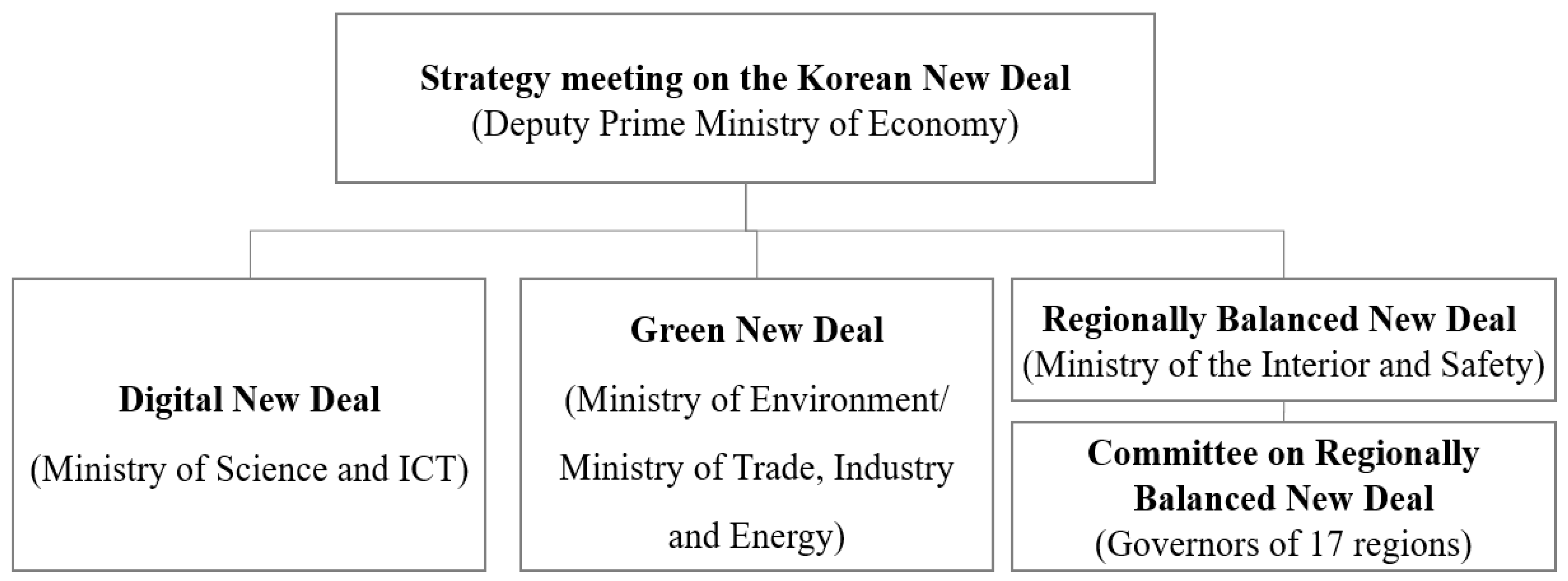
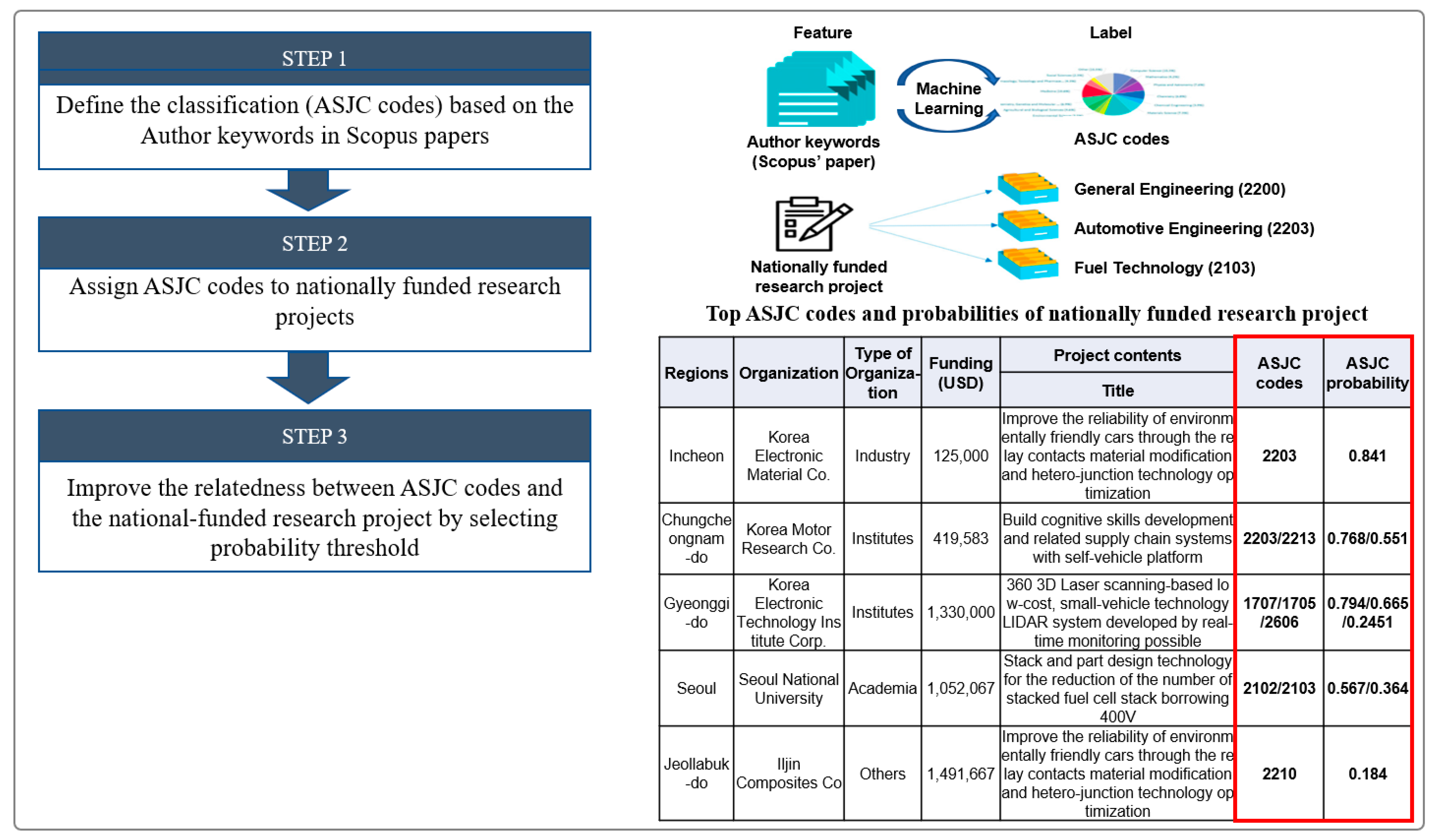
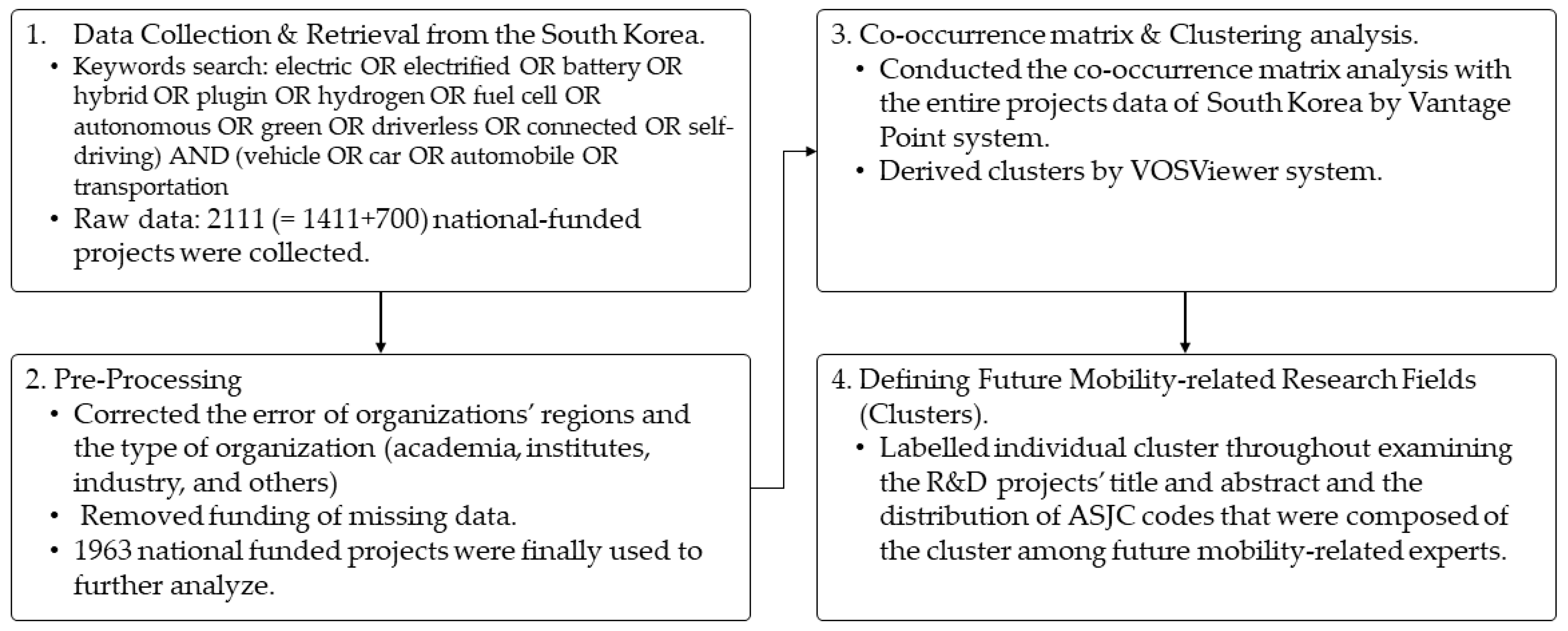
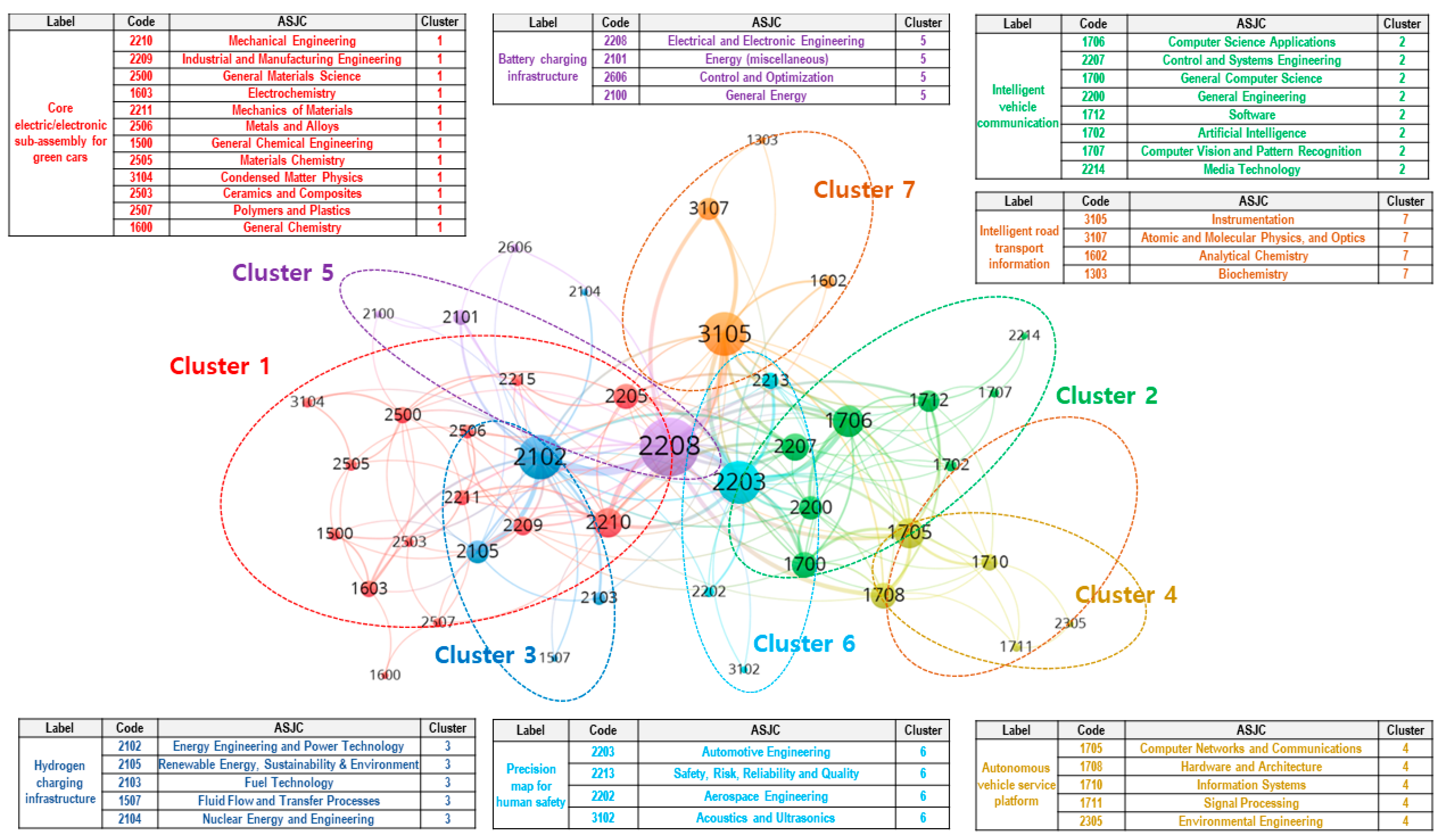
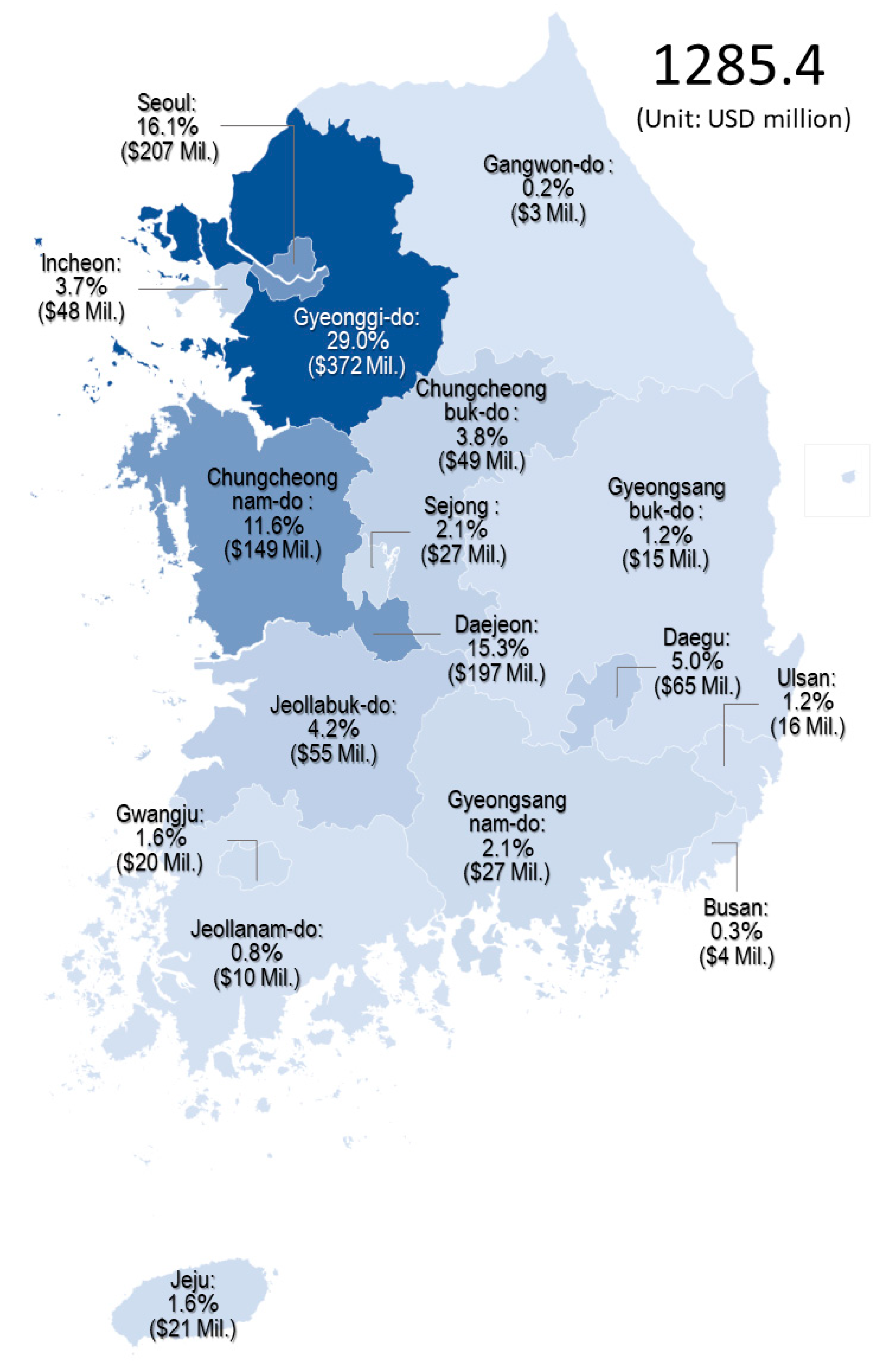
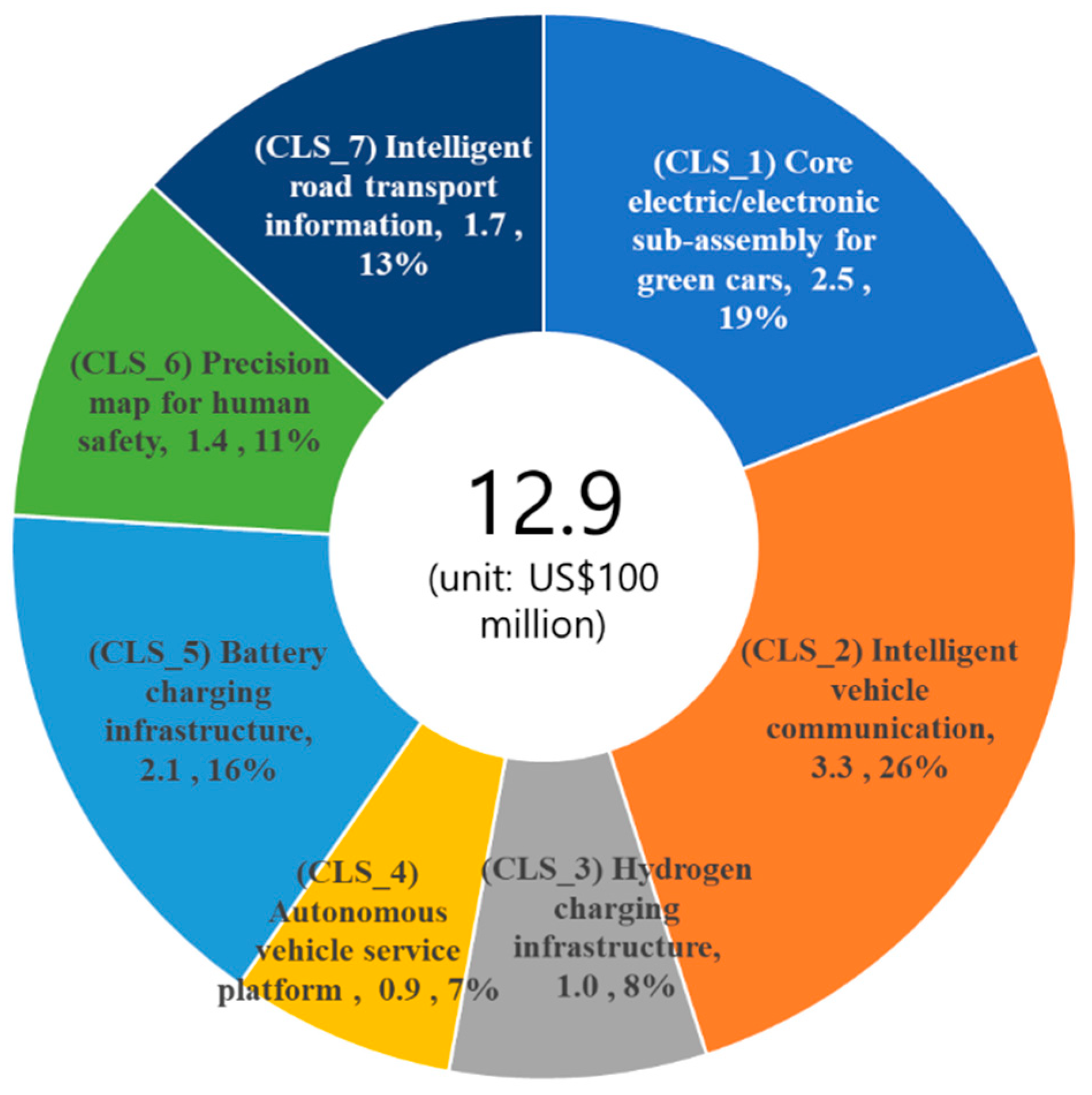
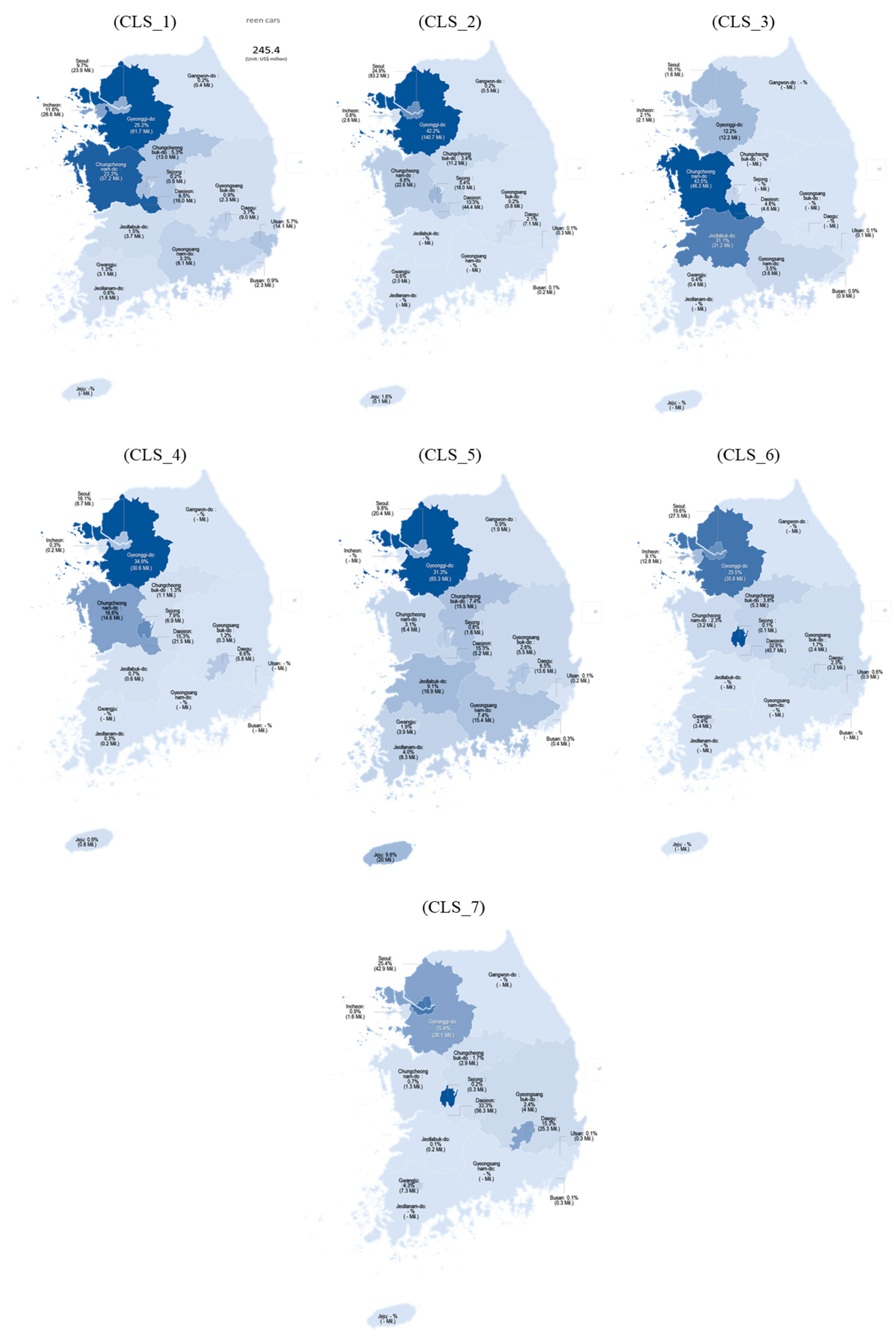
| Regions | Unique Identification Number (ID) | Organization | Type of Organization | Research Program | Funding (USD) | Project Period | Project Contents | ||
|---|---|---|---|---|---|---|---|---|---|
| Start Date | End Date | Title | Abstract | ||||||
| Incheon | 1415143912 | Korea Electronic Material Co. | Industry | Material-parts, equipment for infrastructure | 125,000 | 2015-07-01 | 2016-06-30 | Improve the reliability of environmentally friendly cars through the relay contacts material modification and hetero-junction technology optimization | Arc Chamber Assy improving (1) Co. Korea electronic materials (lead organization) conventional contact material composition and process optimization (alloy composition, sintering conditions, etc.)—the electrical properties of the contacts composition and … |
| Chungcheongnam-do | 1415139977 | Korea Motor Research Corp. | Institutes | Development of core technology for transportation system industry | 419,583 | 2015-05-01 | 2016-04-30 | Build cognitive skills development and related supply chain systems with self-vehicle platform | autonomous vehicle platform development—autonomous vehicle platform system architecture development—surround sensors and autonomous mandatory system. identification information based on the mission carried out the vehicle path management technology for—Mission generate specific path requirements analysis—mission-specific … |
| Gyeonggi-do | 1415143557 | Korea Electronics Technology Institute Corp. | Institutes | Industrial convergence technology, industrial core technology | 1,330,000 | 2015-12-01 | 2018-11-30 | 360 3D Laser scanning-based low-cost, small-vehicle technology LiDAR system developed by real-time monitoring possible | (1) LIDAR transceiver system design and development—LIDAR specifications for the transmission and reception system and the requirements analysis—Laser signal and developing a light source module …. (8) point cloud data Emitter modeling and object recognition technology—point cloud data modeling … |
| Seoul | 1415140513 | Seoul National University | Academia | Automobile industry technology development (Green Car) | 1,052,067 | 2015-06-01 | 2020-05-31 | Stack and part design technology for the reduction of the number of stacked fuel cell stack borrowing 400 V | (1) The cell unit used in the study in each of the participating institutions Design and Implementation. (6) large area dual cell design and graphite separation applying the trial product manufactured, performance analysis of Flow stack manifold designs and separated by plate internal manifold designs … |
| Jeollabuk-do | 1415140517 | Iljin Composites Company LTD. | Others | Automobile industry technology development (Green Car) | 1,491,667 | 2018-06-01 | 2022-12-28 | Improve the reliability of environmentally friendly cars through the relay contacts material modification and hetero-junction technology optimization | Low Permeation/lightweight liner developed—and developing lightweight liner through hydrogen high barrier material development. High-performance epoxy (Toughened epoxy) Development …. the silica using a filler, the impact resistance reinforcing Toughened epoxy—the manufacture composite … |
| Search Terms | Time Period | Amount of Raw Data | Number of Data Utilized |
|---|---|---|---|
| ((electric * OR electrified OR battery OR hybrid * OR plug-in * OR hydrogen * OR fuel cell OR autonomous OR green OR driverless OR connected OR self-driving) AND (vehicle * OR car * OR automobile* OR transportation *)) | 2015–2020 | 2111 | 1963 |
| Region | Funding (USD Million) | No. Projects | Funding Per Project | Funding (%) |
|---|---|---|---|---|
| Gangwon-do | 2.9 | 14 | 2.5 | 0.2% |
| Gyeonggi-do | 372.5 | 504 | 8.9 | 29.0% |
| Gyeongsangnam-do | 27.1 | 35 | 9.3 | 2.1% |
| Gyeongsangbuk-do | 15.3 | 87 | 2.1 | 1.2% |
| Gwangju | 20.2 | 58 | 4.2 | 1.6% |
| Daegu | 64.5 | 92 | 8.4 | 5.0% |
| Daejeon | 196.8 | 283 | 8.3 | 15.3% |
| Busan | 4.5 | 41 | 1.3 | 0.3% |
| Seoul | 207.0 | 394 | 6.3 | 16.1% |
| Sejong | 27.4 | 69 | 4.8 | 2.1% |
| Ulsan | 15.8 | 38 | 5.0 | 1.2% |
| Incheon | 47.9 | 59 | 9.7 | 3.7% |
| Jeollanam-do | 10.1 | 11 | 11.1 | 0.8% |
| Jeollabuk-do | 54.6 | 59 | 11.1 | 4.2% |
| Jeju | 20.8 | 26 | 9.6 | 1.6% |
| Chungcheongnam-do | 148.9 | 131 | 13.6 | 11.6% |
| Chungcheongbuk-do | 49.2 | 62 | 9.5 | 3.8% |
| Total/Average | 1285.4 | 1963 | 7.9 | 100.0% |
| Funding (USD Million) | 2015 | 2016 | 2017 | 2018 | 2019 | 2020 | Total | 15–19 CAGR |
|---|---|---|---|---|---|---|---|---|
| (CLS_1) Core electric/electronic sub-assembly for green cars | 9.8 | 25.4 | 47.8 | 51.9 | 74.2 | 36.2 | 245.4 | 65.7% |
| (CLS_2) Intelligent vehicle communication | 11.6 | 43.4 | 63.4 | 69.3 | 83.7 | 62.3 | 333.7 | 64.0% |
| (CLS_3) Hydrogen charging infrastructure | 5.1 | 10.5 | 16.4 | 25.3 | 27.1 | 16.1 | 100.4 | 51.9% |
| (CLS_4) Autonomous vehicle service platform | 1.1 | 6.0 | 10.8 | 20.0 | 24.9 | 25.0 | 87.8 | 116.3% |
| (CLS_5) Battery charging infrastructure | 17.2 | 22.4 | 40.2 | 52.0 | 51.6 | 25.5 | 208.8 | 31.7% |
| (CLS_6) Precision map for human safety | 12.0 | 24.2 | 32.8 | 32.4 | 21.4 | 17.3 | 140.3 | 15.5% |
| (CLS_7) Intelligent road transport information | 12.3 | 18.2 | 39.4 | 32.2 | 39.7 | 27.2 | 169.0 | 34.0% |
| Total | 69.2 | 150.0 | 250.9 | 283.2 | 322.7 | 209.5 | 1285.4 | 47.0% |
| (Unit: USD Million) | Total | (CLS_1) Core Electric/Electronic Sub-Assembly for Green Cars | (CLS_2) Intelligent Vehicle Communication | (CLS_3) Hydrogen Charging Infrastructure | (CLS_4) Autonomous Vehicle Service Platform | (CLS_5) Battery Charging Infrastructure | (CLS_6) Precision Map for Human Safety | (CLS_7) Intelligent Road Transport Information |
|---|---|---|---|---|---|---|---|---|
| Gangwon-do | 2.9 | 0.4 | 0.5 | - | - | 1.9 | - | - |
| Gyeonggi-do | 372.5 | 61.7 | 140.7 | 12.2 | 30.6 | 65.3 | 35.8 | 26.1 |
| Gyeongsangnam-do | 27.1 | 8.1 | 0.0 | 3.6 | - | 15.4 | - | - |
| Gyeongsangbuk-do | 15.3 | 2.3 | 0.8 | - | 0.3 | 5.5 | 2.4 | 4.0 |
| Gwangju | 20.2 | 3.1 | 2.0 | 0.4 | - | 3.9 | 3.4 | 7.3 |
| Daegu | 64.5 | 9.0 | 7.1 | - | 5.8 | 13.6 | 3.2 | 25.8 |
| Daejeon | 196.8 | 16.0 | 44.4 | 4.6 | 18.9 | 10.8 | 45.7 | 56.3 |
| Busan | 4.5 | 2.3 | 0.2 | 0.9 | 0.0 | 0.8 | - | 0.3 |
| Seoul | 207.0 | 23.9 | 83.2 | 1.6 | 7.6 | 20.4 | 27.5 | 42.9 |
| Sejong | 27.4 | 0.5 | 18.0 | - | 6.9 | 1.6 | 0.1 | 0.3 |
| Ulsan | 15.8 | 14.1 | 0.3 | 0.1 | 0.0 | 0.2 | 0.9 | 0.3 |
| Incheon | 47.9 | 28.6 | 2.6 | 2.1 | 0.2 | 0.0 | 12.8 | 1.6 |
| Jeollanam-do | 10.1 | 1.6 | - | - | 0.2 | 8.3 | - | - |
| Jeollabuk-do | 54.6 | 3.7 | - | 31.2 | 0.6 | 18.9 | - | 0.2 |
| Jeju | 20.8 | - | 0.1 | - | 0.8 | 20.0 | - | - |
| Chungcheongnam-do | 148.9 | 57.2 | 22.6 | 43.6 | 14.6 | 6.4 | 3.2 | 1.3 |
| Chungcheongbuk-do | 49.2 | 13.0 | 11.2 | - | 1.1 | 15.5 | 5.3 | 2.9 |
| Total | 1285.4 | 245.4 | 333.7 | 100.4 | 87.8 | 208.8 | 140.3 | 169.0 |
| (Unit: USD Thousand) | Organization | Gangwon-do | Gyeonggi-do | Gyeongsangnam-do | Gyeongsangbuk-do | Gwangju | Daegu | Daejeon | Busan | Seoul | Sejong | Ulsan | Incheon | Jeollanam-do | Jeollabuk-do | Jeju | Chungcheongnam-do | Chungcheongbuk-do | Avg(w/o zero) |
|---|---|---|---|---|---|---|---|---|---|---|---|---|---|---|---|---|---|---|---|
| (CLS_1) Core electric/electronic sub-assembly for green cars | Academia | 308 | 1902 | - | 271 | 142 | 88 | 1339 | 906 | 5956 | 466 | 1216 | 312 | - | 449 | - | 100 | 76 | 966.4 |
| Institutes | - | 4394 | - | - | 18 | - | 8976 | - | 38 | - | - | - | - | - | - | 52,640 | - | 13,213.1 | |
| Industry | - | 47,260 | 3455 | 1224 | 2961 | 8894 | 5710 | 1349 | 17,859 | - | 741 | 28,244 | 1587 | 3174 | - | 4439 | 12,953 | 9989.3 | |
| Others | 125 | 8187 | 4656 | 821 | - | 22 | - | - | - | - | 12,096 | - | - | 27 | - | - | - | 3705.0 | |
| (CLS_2) Intelligent vehicle communication | Academia | - | 1965 | - | 777 | 963 | 2358 | 1147 | - | 40,659 | 500 | 224 | - | - | - | - | - | 11,230 | 6646.9 |
| Institutes | - | 20,459 | 38 | - | - | - | 35,150 | - | 83 | 11,462 | - | - | - | - | - | 22,573 | - | 14,960.7 | |
| Industry | - | 80,372 | - | - | 1056 | 4753 | 8076 | 187 | 41,085 | 6064 | 80 | 2595 | - | - | 56 | 68 | - | 13,126.5 | |
| Others | 503 | 37,892 | - | - | - | - | - | - | 1346 | - | - | - | - | - | - | - | - | 13,246.8 | |
| (CLS_3) Hydrogen charging infrastructure | Academia | - | - | - | - | 417 | 13 | 1284 | 42 | 586 | - | 83 | - | - | - | - | - | - | 403.9 |
| Institutes | - | - | - | - | - | - | 3263 | - | 38 | - | - | - | - | - | - | 22,508 | - | 8602.9 | |
| Industry | - | 11,828 | 3552 | - | - | - | 28 | 890 | 992 | - | - | 2088 | - | 29,083 | - | 3885 | - | 6543.3 | |
| Others | - | 413 | - | - | - | - | - | - | - | - | - | - | - | 2160 | - | 17,257 | - | 6610.1 | |
| (CLS_4) Autonomous vehicle service platform | Academia | - | - | - | 143 | - | 2233 | 8470 | - | 3471 | 135 | 31 | 235 | - | 58 | - | 13 | - | 1643.3 |
| Institutes | - | 10,554 | - | - | - | - | 1990 | - | - | 4688 | - | - | - | - | - | 14,539 | - | 7942.8 | |
| Industry | - | 12,075 | - | 149 | - | 117 | 8459 | 31 | 4154 | 2102 | - | - | 223 | 577 | 796 | - | 1136 | 2710.8 | |
| Others | - | 7984 | - | - | - | 3453 | - | - | - | - | - | - | - | - | - | - | - | 5718.3 | |
| (CLS_5) Battery charging infrastructure | Academia | - | 1385 | 31 | 1398 | 115 | 121 | 980 | 79 | 2946 | - | 200 | 35 | - | 325 | - | 9 | - | 635.3 |
| Institutes | - | 10,593 | 10,401 | - | - | - | 7992 | - | 1404 | - | - | - | - | - | - | 3682 | - | 6814.6 | |
| Industry | 1932 | 53,098 | 4988 | 4097 | 3826 | 13,455 | 1866 | 717 | 16,046 | 1625 | - | - | 8338 | 6474 | 4308 | - | 15,543 | 9736.6 | |
| Others | - | 273 | - | 3 | - | - | - | - | - | - | - | - | - | 12,133 | 15,662 | 2749 | - | 6164.1 | |
| (CLS_6) Precision map for human safety | Academia | - | 3319 | - | 633 | - | 1106 | 753 | - | 7613 | 83 | - | 42 | - | - | - | - | 42 | 1698.9 |
| Institutes | - | 4851 | - | - | - | - | 38,802 | - | - | - | - | - | - | - | - | 3173 | - | 15,608.6 | |
| Industry | - | 25,471 | - | 1764 | 3399 | 2117 | 6192 | - | 19,821 | - | 859 | 12,743 | - | - | - | - | 5299 | 8629.6 | |
| Others | - | 2114 | - | - | - | - | - | - | 65 | - | - | - | - | - | - | - | - | 1089.6 | |
| (CLS_7) Intelligent road transport information | Academia | - | 1350 | - | 1398 | 5891 | 1042 | 5815 | - | 13,509 | 266 | 251 | - | - | 167 | - | 42 | - | 2973.1 |
| Institutes | - | 9058 | - | - | - | - | 28,951 | - | 4498 | - | - | - | - | - | - | 1112 | - | 10,904.9 | |
| Industry | - | 15,604 | - | 2611 | 1373 | 4557 | 9973 | 251 | 24,857 | - | - | 1580 | - | - | - | 97 | 2933 | 6383.6 | |
| Others | - | 79 | - | - | - | 20,212 | 11,540 | - | - | - | - | - | - | - | - | - | - | 10,610.1 | |
| TOTAL | Academia | 308 | 9922 | 31 | 4620 | 7526 | 6960 | 19,787 | 1027 | 74,739 | 1451 | 2004 | 624 | - | 999 | - | 164 | 11,348 | 9434.0 |
| Institutes | - | 59,909 | 10,439 | - | 18 | - | 125,124 | - | 6061 | 16,149 | - | - | - | - | - | 120,228 | - | 48,275.5 | |
| Industry | 1932 | 245,709 | 11,996 | 9844 | 12,614 | 33,893 | 40,305 | 3425 | 124,814 | 9790 | 1681 | 47,250 | 10,148 | 39,308 | 5159 | 8488 | 37,865 | 37,895.3 | |
| Others | 628 | 56,942 | 4656 | 825 | - | 23,686 | 11,540 | - | 1411 | - | 12,096 | - | - | 14,321 | 15,662 | 20,005 | - | 14,706.6 |
| Region | Type of Organization | Organization | R&D Title | Project Manager | Funding (USD Thousand) |
|---|---|---|---|---|---|
| Gyeonggi-do | Industry | Saetbyul Co., Ltd. | Development of 75 m, 450 g, 360 degrees 3D real-time imaging LIDAR sensor based on MEMS-pinhole single-cell transceiver for application to unmanned automotive vehicles | Wookyung Shin | 1231.4 |
| Academia | Sungkyunkwan University | The development of a new stereo matching technology with using different kinds of cameras to acquire distance information | Jaewook Jeon | 397.7 | |
| Institutes | Korea Electronics Technology Institute (KETI) | Development of Low-cost and Small LIDAR System Technology based on 3D Laser scanning for 360° Real-Time Monitoring | Yeongook Moon | 3972.9 | |
| Others | Korea Testing Laboratory | Test Environment and Test Cases development of Image-Based Lane Departure Warning System for Smart Digital Tachograph | Gukju Iim | 79.2 | |
| Gyeongsangbuk-do | Industry | Tyco AMP Co., Ltd. | Development of MOD System based on Automotive LWIR Thermal Stereo typed Camera for applying AEB | Sangjun Jung | 2611.1 |
| Academia | Yeungnam University | MIMO Scanning LIDAR using DS-OCDMA | Yongwan Park | 555.0 | |
| Gwangju | Industry | SOS Lab Co., Ltd. | 150 m class for autonomous navigation/ADAS LA of the vehicle is small development | Jisung Jung | 551.5 |
| Academia | Gwangju Institute of Science and Technology (GIST) | Development of an open dataset and cognitive processing technology for the recognition of features derived from unstructured human (police officers, traffic safety officers, pedestrians, etc.) motions used in self-driving cars | Yonggu Lee | 2103.2 | |
| Daegu | Industry | Spring Cloud Co., Ltd. | Driving situations that the process of assessment and verification of SW platform | Youngki Song | 3972.9 |
| Academia | Daegu Gyeongbuk Institute of Science and Technology (DGIST) | Core technology development of autonomous cars | Wooyoung Jung | 640.3 | |
| Others | Korea Intelligent Automotive Parts Promotion Agency | Development of validation techniques based on real roads for reliability evaluation of the autonomous vehicle systems | Kyungsoo Yoon | 13,008.5 | |
| Daejeon | Industry | Dyin Industries Co., Ltd. | Development of ultra-lightweight and low-cost LiDAR sensor module | Deokbae Lee | 2484.7 |
| Academia | Korea Advanced Institute of Science and Technology (KAIST) | Development of Deep Learning-Based Future Prediction and Risk Assessment technology considering Inter-vehicular Interaction in Cut-in Scenario | Dongseok Keum | 2364.9 | |
| Institutes | Electronics and Telecommunications Research Institute (ETRI) | Development of Driving Computing System Supporting Real-time Sensor Fusion Processing for Self-Driving Car | Seonghoon Kim | 8166.7 | |
| Others | Center for Integrated Smart Sensors | Application of smart camera system | Jongmin Kyung | 11,539.6 | |
| Seoul | Industry | Dongwoon Anatech | Development of Next-Generation Smart Camera DSLR-level Multi-Eyes Driving SoC | Jin Park | 5616.5 |
| Academia | Hanyang University | Development of Traffic Jam Assist System for EV based on Affordable Sensors | Myungho Sunwoo | 2337.0 | |
| Institutes | Korea Institute of Science and Technology (KIST) | Development of complex cognitive core technology for optimal identification and inference under spatio-temporal-view changes | Ik-jae Kim | 4498.3 | |
| Sejong | Academia | Hongik University | Deep learning-based array antenna multiple object location tracking using time series correlation and its generalization | Dosik Yoo | 114.6 |
| Ulsan | Academia | Ulsan National Institute of Science and Technology (UNIST) | Research on a flash-type high-accuracy high-resolution CMOS LiDAR sensor with background light suppression | Seongjin Kim | 250.8 |
| Incheon | Industry | Carnavicom Co., Ltd. | The Development of the 8-channel 15 f/s grade scanning LiDAR for autonomous car | Jongtaek Jeong | 1475.5 |
| Jeollabuk-do | Academia | Chonbuk National University | Development of Artificial Intelligence for Autonomous Farming via Deep Learning of Semantic Graphics | Hyungseok Kim | 166.7 |
| Chungcheongnam-do | Industry | Dongoh Precision Co., Ltd. | Development of technology to recognize characteristics and location of surrounding sounds for safety driving of autonomous vehicles | Dongran Shin | 96.9 |
| Academia | Hoseo University | A Fundamental Study of the Optical Camera Communication-based Autonomous Vehicles | Byungwook Kim | 41.7 | |
| Institutes | Korea Automotive Technology Institute (KATECH) | The development of future technology for mixed traffic intersection integrated environmental information regarding the autonomous at the crossroads of the city | Jungwook Lee | 1111.7 | |
| Chungcheongbuk-do | Industry | Power Logics Co., Ltd. | Development of automotive camera modules of 1.3MP or higher for mirrorless cars and dash cams and development of smart manufacturing systems with linear position accuracy of ±1 μm | Jeonwhan Choi | 2333.3 |
Publisher’s Note: MDPI stays neutral with regard to jurisdictional claims in published maps and institutional affiliations. |
© 2021 by the authors. Licensee MDPI, Basel, Switzerland. This article is an open access article distributed under the terms and conditions of the Creative Commons Attribution (CC BY) license (https://creativecommons.org/licenses/by/4.0/).
Share and Cite
Lee, D.; Kim, K. A Collaborative Trans-Regional R&D Strategy for the South Korea Green New Deal to Achieve Future Mobility. Sustainability 2021, 13, 8637. https://doi.org/10.3390/su13158637
Lee D, Kim K. A Collaborative Trans-Regional R&D Strategy for the South Korea Green New Deal to Achieve Future Mobility. Sustainability. 2021; 13(15):8637. https://doi.org/10.3390/su13158637
Chicago/Turabian StyleLee, Doyeon, and Keunhwan Kim. 2021. "A Collaborative Trans-Regional R&D Strategy for the South Korea Green New Deal to Achieve Future Mobility" Sustainability 13, no. 15: 8637. https://doi.org/10.3390/su13158637
APA StyleLee, D., & Kim, K. (2021). A Collaborative Trans-Regional R&D Strategy for the South Korea Green New Deal to Achieve Future Mobility. Sustainability, 13(15), 8637. https://doi.org/10.3390/su13158637





